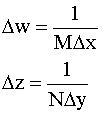
















 | |
Jan 24, 2001
Discrete Fourier Transforms
The discrete Fourier transform pair for a sampled space array f(x, y) of dimensions
M x N to a frequency array F(w, z):



Properties of two-dimensional Fourier transform (assume M=N):
 | Commutivity:
[af(x,y)
+ bg(x,y)] ó aF(w,z) + bG(w,z)
|
 | Translation:
f(x, y)
exp[j2π(wox + zoy)/N]
F(w - wo, z - zo)
f(x - xo,
y - yo) F(w, z) exp[-j2π(wxo
+ zyo)/N]
|
 |
Periodicity:
F(w,z)
= F(w+N, z) = F(w, z+N) = F(w+N, z+N)
|
 | Rotation:
Let x =
r cos θ,
y = r sin θ, w = ρ cos φ, z = ρ sin φ
Then f(r, θ + θo) ó
F(ρ, φ + θo)
|
 | Scaling:
a f(x,
y) ó a F(w, z)
f(ax,
by) ó (1/|ab|)F(w/a, z/b) |

The Fourier transform of a constant valued image is a delta function
located at (0,0) and multiplied by the constant value.
f(x,y) ó Aδ(m,n)
The comb function preserves its form under a Fourier transform:


Convolution

A basic reason for the importance of the Fourier transform is that it
allows the mathematical complexity of a convolution integral to be replaced
by the product of Fourier transforms.

Do Homework Assignment 2.
Last modified on January 29, 2001
|
